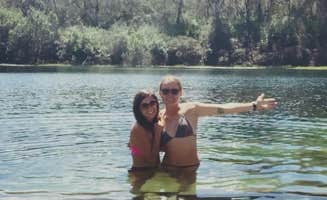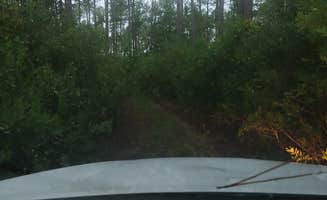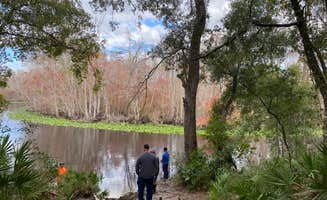Ocala National Forest serves as the primary location for rustic camping near Cassadaga, Florida, with dispersed sites typically located 30-45 miles west of the town. These primitive camping areas offer no developed facilities and are situated on sandy forest roads that can become challenging during wet weather conditions. Winter temperatures average 45-70°F while summer months bring 75-95°F heat with high humidity.
What to do
Explore historic sites: Davenport Landing features a 1.2-mile interpretive trail leading to a former steamboat landing with Civil War-era gravesites and Timucuan Indian middens. "There's a 1.2 mile interpretive hiking trail called Davenport Landing Trail that will take to you to the former steamboat landing, which makes for a medium-grade hike with some interesting history," notes Stuart K. from Davenport Landing.
Water recreation: Multiple dispersed sites provide water access for swimming, fishing, and paddling. The Ocklawaha River at Davenport Landing offers emerald-green waters lined with lily pads. "It's super secluded and quiet. Great place to put a kayak in the water," shares Adamm A. about Freak Creek Dispersed Camping.
Stargazing: Sandy clearings among pine forests create natural observation points for astronomy enthusiasts. The tree canopies at some sites open to reveal excellent night sky views. "The roads to get here are bumpy. Right next to the river and the trees open up so you get a great view of the stars," explains Mike D. about his experience at St. Johns River Dispersed Spot.
What campers like
Natural isolation: The challenging access routes deter casual visitors, creating genuine wilderness experiences. "Very narrow trails but really easy access, you will leave with some new pinstripes," shares Joe P. about Trout Lake Primitive Sites. The difficulty reaching these locations means campers often have entire areas to themselves.
Wildlife encounters: Florida's native species frequent these undeveloped camping areas. According to hilary G., "I talked to another person that use to go out there and said she has seen a panther. I've yet to see anything." Alligators, black bears, and various bird species are commonly spotted near water features.
Forest shade: The mature tree canopy provides natural cooling during hot Florida days. "We didn't see anything bad with this place when we were there. Had no one around and nice and cool in the forest," reports Ethan B. about his stay at Davenport Landing. Magnolias, sweetgum, and red maple trees create distinctive camping environments throughout the forest.
What you should know
Vehicle requirements: Most dispersed sites demand high-clearance vehicles with four-wheel drive. "The main road in has huge deep ruts, the other road has a water crossing that was over my bumper on my lifted Mojave. If you don't have 4wd and recovery gear I wouldn't risk it," warns hilary G. about Freak Creek Dispersed Camping.
Access challenges: Roads to primitive sites feature tight clearances between trees, deep sand, and sometimes water crossings. "Main road entry is packed dirt; smaller access road to sites is two-track about 1/4 mile through woods — very narrow tree clearance. 4WD recommended," explains Entropical Breeze E. about Trout Lake Primitive Sites.
Safety concerns: Some camping areas have developed reputations for unsafe conditions. "Attempted to stay at this campground but left because it felt unsafe. Spoke to a local that warned of violence, robbery, and killings in this area of the national forest," cautions Michael S. regarding Lake Dorr.
No facilities: All dispersed sites lack amenities including potable water, trash collection, and toilets. Self-containment is mandatory for waste management. Cell service remains minimal or non-existent in most locations.
Tips for camping with families
Choose sites carefully: Select locations based on access difficulty and reported safety conditions. "Pulled in around 9:30 pm. Big open spot. Last 100 yards driving back in were very bumpy but no problem with our van. Not sure about a larger RV. But great Tent/van spot," advises David P. about Davenport Landing.
Pack extra water: Florida's humidity increases water consumption needs. Each person requires at least 1 gallon per day plus additional water for cooking and cleaning.
Establish boundaries: Wildlife activity requires clear rules about wandering from camp. Children should remain visible to adults at all times due to potential encounters with bears, alligators, and other wildlife.
Bring multiple navigation tools: GPS devices often lose signal under dense forest canopy. Physical maps of Ocala National Forest should accompany electronic navigation systems.
Tips from RVers
Scout ahead: When possible, investigate potential sites without your RV before attempting access. "Set of primitive spots near lake. Just barely scraped a FWD Promaster through the trees, into a pullout just before sand started," shares Entropical Breeze E. about their experience at Trout Lake Primitive Sites.
Stay on established paths: Creating new routes damages forest undergrowth and can lead to becoming stuck in soft sand or mud.
Monitor weather forecasts: Rain significantly worsens road conditions and can create impassable situations for larger vehicles. Plan arrivals and departures during dry periods.
Prepare for scratches: Narrow access roads guarantee exterior contact with vegetation. "You will leave with some new pinstripes," notes Joe P. about the tight clearances at Trout Lake Primitive Sites.




